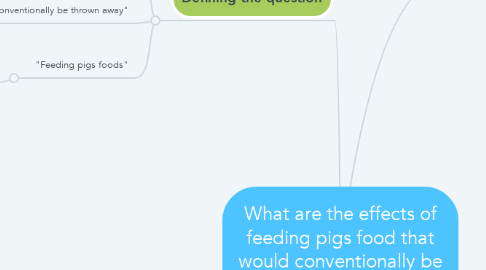
1. Defining the question
1.1. "What are the effects"
1.1.1. The various factors that could change due to changing the pigs diet from grains to foods that would conventionally be thrown away
1.2. "Conventionally be thrown away"
1.2.1. Foods that are fit for human and pig consumption, but are not consumed due to technicalities such as aesthetics or conventions.
1.3. "Feeding pigs foods"
1.3.1. The foods would be fit for consumption by pigs and be safe
2. Ethical Considerations
2.1. Research methods
2.1.1. Interviews
2.1.1.1. Consent for interviewee's participation
2.1.1.2. Ensuring questions are not offensive, discriminatory or influence bias answers from the interviewee.
2.1.1.3. Respect for the interviewee's privacy, particularly ensure not to disclose any personal information. Also, if they wish to remain anonymous in the findings.
2.1.1.4. Informing the interviewee of what the information collected will be used for.
2.1.1.5. Respecting if the interviewee wishes to not answer a question or withdraw from the interview completely.
2.1.2. Surveys
2.1.2.1. Informing the participant of the intentions for the information collected.
2.1.2.2. Informing the participant of their right to withdraw from the survey at any stage and participation in survey is completely voluntary.
2.1.2.3. Ensuring questions are not written to persuade participant to answer a certain way, neutral questions.
2.1.3. Literature Reviews
2.1.3.1. Correctly referencing information to pay respects to author of the source.
2.1.3.2. Not plagiarising another persons work
3. Effects
3.1. Economical
3.1.1. Scope for increasing profits
3.2. Environmental
3.2.1. Wastage and landfill
3.2.2. Emission of greenhouse gases
3.3. Political
3.3.1. Policies, laws and legislation involved in farming
3.4. Practicality
3.4.1. Transportation of foods
3.4.2. Foods ability to 'keep' before use
3.5. Physical (on the pigs)
3.5.1. Health impacts
3.5.2. Nutrition and dietary impacts
3.6. Ethical
3.6.1. Should we be feeding this food to pigs?
3.6.2. Should we find better uses for the food?
3.6.3. How could the food be distributed to have more benefits?
4. Research Methods
4.1. Literature Review
4.1.1. To gain a deeper understanding of the topic in order to draw conclusions and back up statements.
4.1.1.1. Sources
4.1.1.1.1. Journal articles
4.1.1.1.2. Research papers
4.1.1.1.3. TED Talks
4.1.1.1.4. Educational Youtube Videos
4.1.1.1.5. Peer Reviewed Articles
4.2. Interviews
4.2.1. Used to gain a deeper understanding and knowledge base and a hands on, experienced point of view.
4.2.1.1. Possible interviewees
4.2.1.1.1. Evironmentalists
4.2.1.1.2. Agriculturalists
4.2.1.1.3. Farmers
4.2.1.1.4. Supermarket employees
4.2.1.1.5. Veterinarians
4.2.1.1.6. Factories for meat processing
4.3. Surveys
4.3.1. Used to indicate areas of knowledge or lack of in the community, to build a foundation for possible interview questions.
